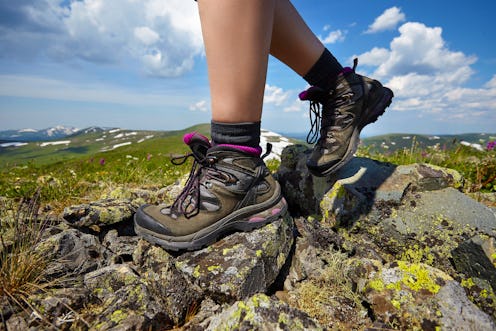Quality hiking boots can be fairly expensive, but it is possible to find a great budget pair when you know what to look for. The biggest factor to consider is what type of hiking you’ll be doing. The best budget hiking boots will vary depending on the use, but generally speaking there are three different types to choose from:
- Day Hiking Trail Shoes: These are typically low-cut or mid-cut shoes with breathable fabric and sometimes partial leather. They will have stiffer, tougher soles than running sneakers. While they won’t be rugged enough for multi-day adventures, they're the perfect choice for easy day-hikes on groomed trails.
- Lightweight Hiking Boots: A mix between trail shoes and backpacking boots, these mid-range boots will be ankle-high and offer extra thickness and added traction without being stiff or uncomfortable.
- Backpacking Boots: This is the toughest type of hiking boots, intended for rough trails or long, extended trips. They’re usually made with full-grain leather uppers and fully waterproof features that can withstand challenging conditions and heavy loads.
If you’re planning to climb mountains or go on rugged, weeks-long adventures, you can also find mountaineering-specific boots and other technical styles. However, these are rarely offered at budget price points. For typical hiking excursions, the list of the best hiking boots below will provide plenty of quality and traction at prices that aren't too steep.
1
The Best Lightweight Hiking Boots
Waterproof and breathable, these lightweight hiking boots are a fantastic crossover choice that fall somewhere between trail shoe and full-on backpacking boot. Constructed with durable suede leather, they're tough enough to withstand rugged trails yet flexible enough to provide comfort and support. These boots have a protective waterproof membrane paired with air-permeable mesh, so your feet won't get too hot. The tough rubber sole provides plenty of traction with its skid-proof tread pattern. The mid-height comes in just above the ankle to provide protection from the elements, while the EVA midsole delivers cushioning, arch support, and moisture management.
2
The Best Day Hiking Trail Shoes
Built with tough suede and a strong rubber sole, these ankle-high hiking shoes offer weatherproof support for easy day-hikes and light trekking. The waterproof Omni-Tech fabric provides a ventilated, seam-sealed membrane to block out the elements while allowing your feet to breathe. The lace-up shoes also showcase a padded tongue and soft collar with a pull tab on the ankle, making them easy to slide on and off. The supportive footbed offers ample cushioning and the rubber sole delivers traction on slippery trails. They come in 14 sizes and three color options. Several reviewers did find that these shoes run small, so you may want to purchase a half or even a full size up if you are normally between two sizes.
3
The Most Budget-Friendly Trail Shoes
These thrifty hiking shoes aren't waterproof and probably won't last for years, but they're an incredible steal for only 22 bucks. They have a leather suede upper that's flexible and supportive, while the soft, cushioned insoles provide comfort during treks. The low-cut style gives you some room around the ankles, and the rubber-EVA sole provides ample traction for moderate day-hikes. On top of that, the insole is soft with plenty of cushioning. These shoes tend to run large, so you may want to order a half or full size smaller than you normally would.
4
The Best Backpacking Boots
Given that most backpacking boots made with full grain leather cost $250 and up, these high-quality boots from Ariat are an exceptional deal. They feature waterproof leather and a weather-resistant membrane that helps keep feet warm and dry. Inside the boot, the cushioned footbed keeps you comfortable and reduces fatigue, even on longer, rockier excursions. The boots are suitable for rough, unmaintained trails with things like dirt, stones, roots, scree, mud, logs, and other technical features. The lining is moisture-wicking, so your feet won’t feel damp or sticky if you start sweating hard. They also have a durable outsole with a grippy tread pattern that clings to the trail and prevents slipping. The only drawback is the ankle height. Unlike with this pair, full-scale backpacking boots typically go past the ankle, but reviewers found they still perform well on long trips.
5
The Best Winter Hiking Boot
If you plan to do any hiking in freezing weather or even in snow, these high-top winter boots offer stellar protection. Suited for cold weather hiking and light backpacking, the boots are constructed with 200-gram Thinsulate which keeps you warm in temperatures as low as -22 degrees. The integrated EVA midsole provides cushioning and lots of arch support, even with an additionally heavy load from your backpack. There's a molded rubber toe-cap, moisture-wicking mesh lining, and a tough rubber outsole. Best of all, the high top offers extra protection from the elements. Some reviewers recommended going a half-size up if you plan to wear these with thicker socks.
6
Hiking Boots With An Exceptional Range of Sizes For The Best Fit
In addition to being a quality pick, these durable hiking boots are also available in a wide variety of sizes, ranging from 5 to 12 with many half-sizes in between. These high boots measure 5.25 inches from the arch and are covered in a water-resistant OmniShield coating. They have a tough rubber outsole for reliable traction, plus waterproof, full-grain leather to keep your feet dry. The interior of these boots features soft, compression-molded EVA foam that delivers comfort and cushioning while keeping foot fatigue at bay. One Amazon reviewer wrote, "These boots held up against all different types of climates and weather and water on my road trip and they still look great! They've also got amazing grip."
Bustle may receive a portion of sales from products purchased from this article, which was created independently from Bustle's editorial and sales departments.
